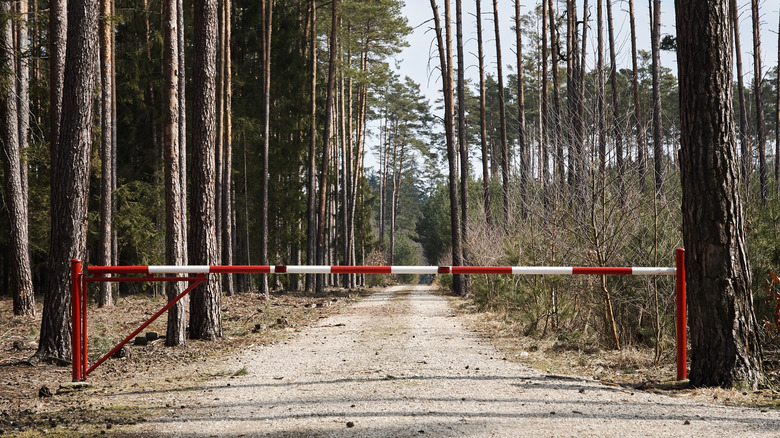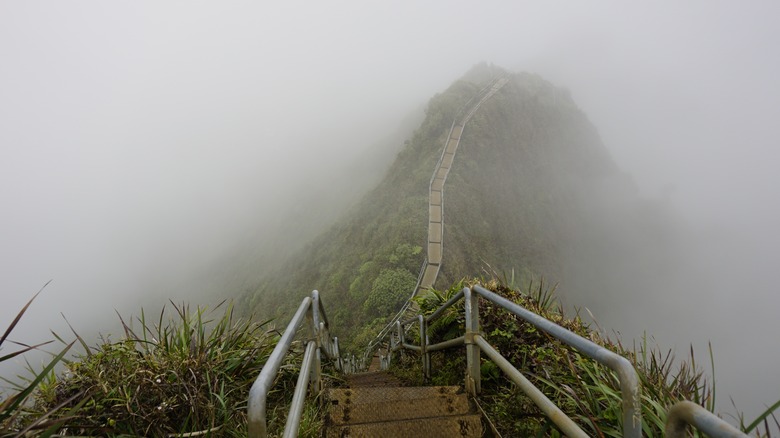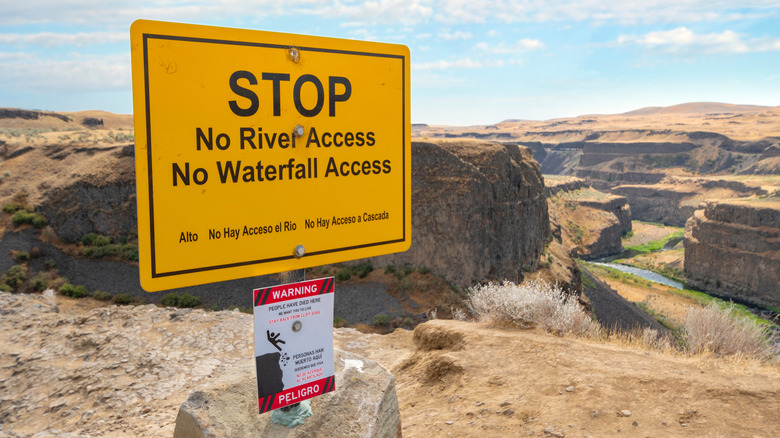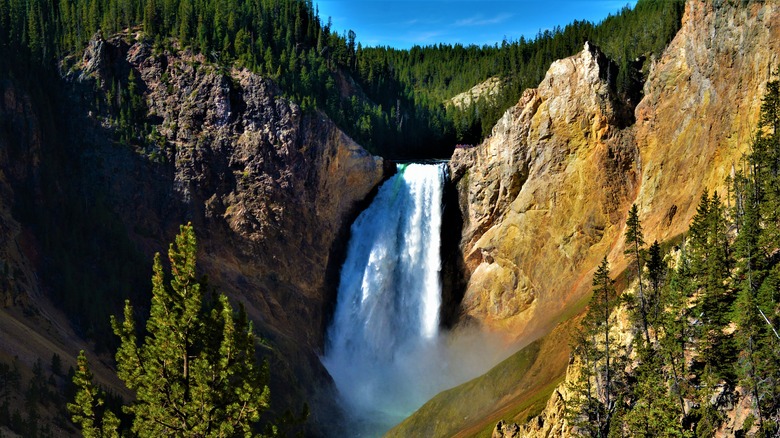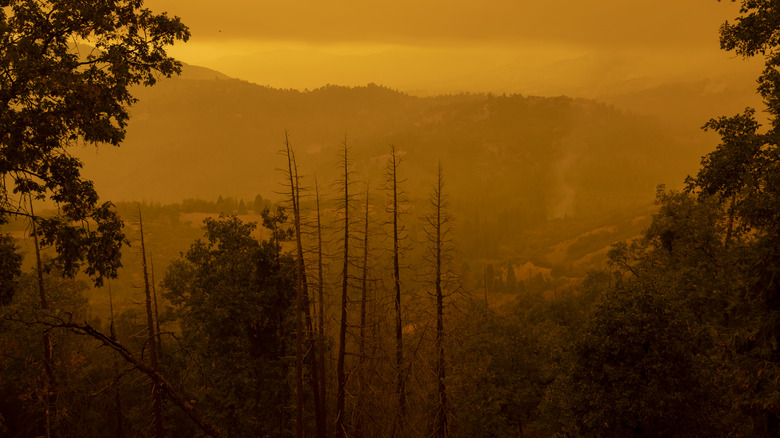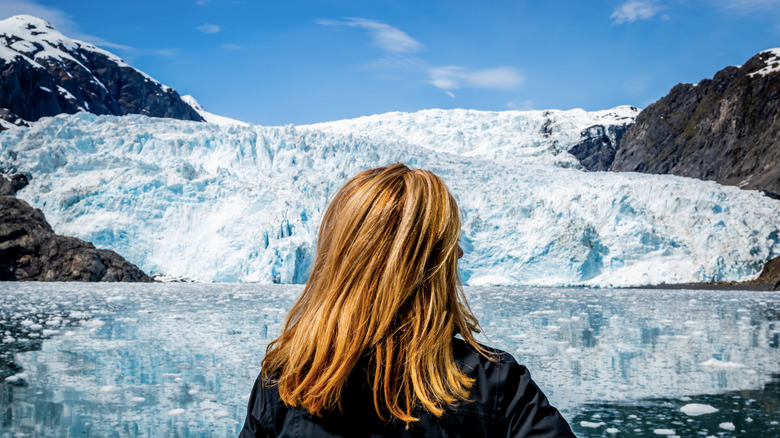Iconic Hiking Trails That Are Now Permanently Closed
For hikers, a trail is more than just a path to conquer; it's a place to connect with nature, friends, family, and yourself. Regardless of your goal, there is no question that certain trails are more attractive than others. Whether this is due to their natural beauty, physical challenges, or exhilarating possibilities, these trails offer an escape that leaves people with the bliss of freedom and adventure. However, popularity also brings some serious issues like environmental impact, trail maintenance, and safety concerns, which have caused some beloved trails to close permanently. This may not mean much to anybody who has never heard of or trekked these paths, but for those who have had the opportunity to — or not — experience these trails, it can be devastating as it is no longer an option.
Before we explore some of these iconic hiking trails that are now permanently closed, let's review some hiking etiquette to ensure this never happens to your favorite existing trails. The first and most important rule is to leave no trace. This means leaving nature in the condition you found it, taking all trash with you, and not disturbing the environment. Second, obey signs and stay on the trail; this will help prevent erosion, protect surrounding vegetation, and, surprise, keep you from dying (but more on that later). While these may seem self-explanatory, they are often overlooked. Now, let's investigate how breaking these rules, along with environmental impacts like weather, may have contributed to the demise of these trails.
Stairway to Heaven or Haʻiku Stairs, Oahu
The Haʻikū Stairs, also known as the Stairway to Heaven, are located on the island of Oahu in Hawaii. The 3,922-step stairs are situated in the Haʻikū Valley and offer a very steep and scenic 2,800-foot climb up to the top of the Ko'olau Mountain Range. However, this wasn't always a hiking trail; it began with the name "Haiku Ladder," built in 1942 as a confidential US Naval Radio Station in response to Pearl Harbour. For many decades after the war, the stairs became a popular trek with its peak visitation at 20,000 hikers per year, especially after the 1981 "Magnum P.I." episode "J. "Digger Doyle"". As a result of vandalism and concerns over liability and safety, the trail was forced to close in 1987.
This, along with a minimum $1,000 fine for trespassing, didn't stop people from ignoring the closure to experience the Stairway to Heaven for themselves. YouTubers, TikTokers, and thrill-seekers seemed to have ruined it for everybody, resulting in the stairs themselves getting destroyed. There was opposition against this: A volunteer initiative named Friends of Haʻikū Stairs (FHS) attempted to save the trail. For FHS and many other local islanders, the Stairway to Heaven is much more than just a hike; it is an iconic historical landmark. Unfortunately, these protests came to no avail. With a $2.5 million, six-month removal plan set in stone by the government, the stairs will soon become history.
Palouse Falls, Washington
Palouse Falls, also known as Aput Aput (meaning "falling water" to the Palouse Natives in Washington), is a 200-foot waterfall carved out 13,000 years ago during the last Ice Age, due to the Missoula glacial floods. Today, the falls remain the only major living piece of that history. In 2014, the falls were declared as Washington's official state waterfall. A 1-mile hike to the falls is renowned for its breathtaking views and challenging terrain. Flanked by vibrant wildflowers and sometimes even the stout yellow-bellied marmot, it's no wonder up to 200,000 visitors make their way to the Palouse Falls State Park every year. Unfortunately, the adventurous hike within the 94-acre State Park leading to this wonder is no longer accessible or permitted.
According to the Washington Trails Organization, "all trails into the canyon and base of Palouse Falls are permanently closed." This includes the body of water below the falls, the narrow trails along the cliffsides, and the view from the top of the falls. Additionally, the nearby and popular climbing formation known as Coyotes Puppies, or the Castle Rock formation, is closed as well. This difficult decision came as a result of visitor negligence despite pretty clear warnings, like: "Warning — People have died here." Tragically, four people have died since 2016 due to failing to adhere to safety rules around the park. Combined with vandalism, dangerous behavior, and trespassing, these incidents have led to the trail's closure.
Uncle Tom's Trail, Wyoming
Since the late 19th century, Uncle Tom's Trail in Yellowstone National Park (Wyoming) has been one to experience. It all started when a local man named H.F Richardson — "Uncle Tom" — decided to build a trail within the Grand Canyon of Yellowstone. Uncle Tom eventually became a sort of "canyon tour guide" as he shepherded visitors from the top of the Grand Canyon to the base of Lower Yellowstone Falls for a picnic. Initially, this path was primitive and rugged, featuring a combination of 528 steps, ropes, and ladders — not for the faint of heart. Time has done its thing, and all that's left is a 500-foot descent down only 328 remaining metal steps and railings.
It may not seem like too much of a challenge. However, this out-and-back 0.6-mile trail can take up to two hours to complete, with the way back being the longest and most difficult. Uncle Tom's Trail was closed mostly due to the fact that, over time, the trail and its infrastructure required significant upkeep to ensure hiker safety. As a result of the harsh weather conditions in Yellowstone, there was structural damage, such as bent treads, missing handrails, cracked welds, and rust, which needed to be regularly addressed to prevent accidents. A refurbishing project for the trail was planned in 2017, but it failed due to high costs (3.5 million dollars at the time of assessment). Consequently, this adrenaline-pumping trail closed in 2019, with the stairs planned for removal.
Crystal Lake Trail, California
When you hear "Crystal Lake," it's natural to think of the "Friday the 13th" franchise. Luckily for Jason Voorhees, this closed hiking trail does not lead to his infamous lake. Nevertheless, the Crystal Lake Trail in California's Sequoia National Park Mineral King Valley was once a killer hike to take on. This popular 9.5-mile hike included a 3,330-foot elevation gain before leading to the serene alpine Crystal Lake, which has a dam (still operating) constructed in 1903. Along the way, hikers could experience natural phenomena such as mountain terrain, alpine meadows, and diverse wildlife, including up to 72 species of mammals and unparalleled panoramic views.
However, there was more to this sublime hike than met the eye: history! As hikers passed the old Chihuahua Mine, old cabins, and caves before climbing to the top viewpoint of Mineral King Valley, they trekked through a landscape initially inhabited by Native American tribes, which was later transformed by 19th-century prospectors following the discovery of silver in the 1870s. It was this mining boom that led to the development of trails to access various areas. Although the Crystal Lake Trail was not directly established for mining, the need for routes contributed to its creation. Sadly, Crystal Lake Trail in Sequoia National Park remains permanently closed due to a 2003 wildfire that caused severe and impassable damage. The wildfire caused fallen trees and washout areas on both the long-side hill and valley trail sections, making the trail too difficult to maintain.
Endangered hiking trails to check out before they close
What's done is done, right? All we can do as nature enthusiasts is ensure the accessibility of hiking trails everywhere before they, too, may have to close — awareness, appreciation, and environmental stewardship go a long way. Unfortunately, there are some endangered hiking trails that are on the line of possibly being permanently closed. These include the Edge of the Glacier Trail due to glacial melting (Kenai Fjords National Park, Alaska), the Arizona Trail due to copper mining projects (Tonto National Forest, Arizona), Long Trail is affected by climate and change and ecosystem imbalance (Mt. Mansfield State Forest, Vermont), lastly, maybe even Horseshoe Bend is endangered due to disrespectful visitors (Glen Canyon National Recreation Area, Arizona).
So, get your hiking boots on, as you might want to explore them — responsibly — before access is entirely restricted. However, for any trail you plan to hike, you should always check online to see if it's open before you arrive. Sometimes, closures can happen suddenly due to inclement weather. If you get to a trail that you see is shut down (hint: signage or bad conditions), get yourself somewhere safe and consider your next steps. If you want to find an alternate hiking route, check online or contact the park to see if any other trails are currently open. Trail closures can be disappointing, but it's important to remain safe and respectful hikers and hope that no trail, popular or not, is ever closed permanently.
